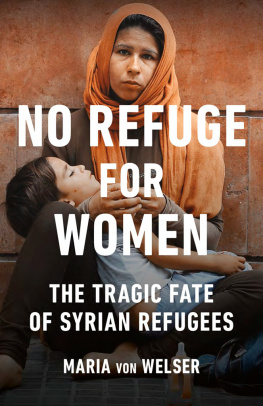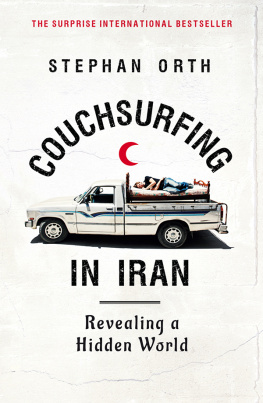
Copyright 2016 by Ludwig Verlag, Munich, part of the Random House GmbH publishing group Originally published in Germany in 2016 as Kein Schutznirgends:
Frauen und Kinder auf der Flucht
English translation copyright 2017 by Jamie McIntosh
First published in English by Greystone Books in 2017
17 18 19 20 21 5 4 3 2 1
All rights reserved. No part of this book may be reproduced, stored in a retrieval system or transmitted, in any form or by any means, without the prior written consent of the publisher or a license from The Canadian Copyright Licensing Agency (Access Copyright). For a copyright license, visit www.accesscopyright.ca or call toll free to 1-800-893-5777.
Greystone Books Ltd.
www.greystonebooks.com
Cataloguing data available from Library and Archives Canada
ISBN 978-1-77164-307-8 (pbk)
ISBN 978-1-77164-308-5 (epub)
Copy editing by Stephanie Fysh
Cover design by Will Brown
Cover photograph by Joseph Eid, Getty Images
Photographs by Peter Mller/BILD-Zeitung and Maria von Wesler
We gratefully acknowledge the support of the Canada Council for the Arts, the British Columbia Arts Council, the Province of British Columbia through the Book Publishing Tax Credit, and the Government of Canada for our publishing activities.

CONTENTS
PREFACE TO THE ENGLISH EDITION
For most of you who will read this, Syria is far, far away. It is 6,681 miles from the center of North America to Aleppo, the second-largest city in Syria, and 7,447 miles to the middle of Australia. But in the fall of 2015, a photograph of a small boy lying on his stomach in the sand on the coast of Turkey was engraved in the minds of people around the world as if it was right in front of us. With the tragic death of 2-year-old Alan Kurdi in September 2015, the war in Syria became more of a reality even in distant countries, filling hearts with compassion. Since then, governments everywhere have discussed the flight of Syrians. Citizens split into camps: do-gooders wanting to offer help and protection, and skeptics and scaremongers warning of terrorists among the asylum-seekers.
What is happening to this world? The accommodation of refugees and migrants is woven into the historical DNA of so many countries. Over the centuries, people have fled from wars, from starvation and economic hardship. Today, 65.3 million people are displaced in the world, 60 percent of them women and children. But we who can comfortably remain in our homes? So many of us readily close our eyes to the dramatic scale of the situation.
With this book I not only tell the stories of people in flight but also provide facts that can take the wind out of critics sails and equip people struggling for freedom and migration with good arguments. But above all, I want to show how refugees lives differ from other migrants lives: Migrants leave their homelands in the hope of a better life, because they feel that that homeland provides no future for them or their children. Refugees, in contrast, flee for their very livesthreatened by bombs, snipers, gas attacks, grenades, imprisonment. For migrants, governments everywhere have clear immigration laws and regulations; these vary from country to country, according to local needs. Refugees from war zones, however, need the protection of everyone in this world. After all, it was not for nothing that in 1951, after the Second World War, 147 nations signed the Refugee Convention in Geneva.
As I write this, the war in Syria has been raging for seven years. The United Nations High Commissioner on Refugees speaks of the greatest refugee crisis in a quarter-century. In February 2017, the international refugee organization stated that there were 4,898,353 registered Syrian refugeesincluding 2.3 million children under the age of 18. Above this, within Syria 13.5 million people are internally displaced, trying to flee from Assads barrel bombs, Russian airstrikes, and the tanks of the ISIS terrorists. But to where? The asylum-seekers I met in camps in Lebanon, Turkey, and Jordan and on the island of Lesbos all wanted to return home when the war is over. For this reason, 87 percent of Syrian refugees remain in these neighboring countries.
But the living conditions I encountered there were anything but fit for human beings. So when, in the summer of 2015, the World Food Programme cut monthly payments to refugees there in half, many of the refugees registered for the UNHCRS resettlement program, in the hope of finding safety in places as faraway as the United States and New Zealand. And it was then that many of Europes twenty-eight nations began to dig in their heels, while Germany opened its borders to 1.2 million asylum-seekersa story that will be told in the pages that follow. Today, 890,000 asylum-seekers no longer live in reception camps but are on the more or less arduous path to integration.
Today, millions of women and children remain stranded in refugee camps, hoping that they will make it to Europe or be accepted for resettlement in the West. But the obstacles to resettlement are immense. The UNHCR reported that in 201516, Canada absorbed 39,671 Syrian refugees; the United States, ten times Canadas size, 18,007; Australia and New Zealand, 15,897 and 750 (!) respectively. I dont like looking at these figures in relation to the total number of inhabitants in the two largest countries of the North American continentthe United States has a population of 318.9 million, compared with Germanys 83 million. Its a disgrace! What has happened to peoples humanity, morality, and empathy?
It is precisely these countries that became strong through migration, including that of refugees. Beginning in about 1830, it was mainly poverty and starvation that forced increasing numbers of people to leave Europe for America18 million people over the course of a century. They came from Great Britain and Ireland, Italy, Spain, and Portugal; from Austria-Hungary, Germany, Sweden, and Norway. In the early twentieth century, 1 to 1.5 million people were leaving Europe annually. In later decades, while Turkish and then Italian Gastarbeiterguest workerswere enticed to Germany by recruitment treaties, the Vietnamese boat people found refuge and new homes in North America. Fifty thousand of those fleeing the Communist regime in Vietnam in the 1980s found refuge in Canada, and 200,000 were resettled in the United States.
Yet as the Syrian refugee crisis emerged four decades later, the response was not the same. David Miliband, former foreign secretary of the UK and now president and CEO of the International Rescue Committee, an organization supporting refugees wanting to resettle in the West, formulated the situation depressingly: The United States has always been a leader in refugee resettlement but 1,500 [Syrian refugees] over four years is such a minuscule contribution to tackling the human side of this problem.
He said this before Donald Trump became president, long before the first closure of U.S. borders to all Syrian refugees. Even before Trump, the resettlement of refugees from the camps in Jordan and Lebanon to the United States was a complicated process, with multiple rounds of background searches, medical tests, and interviews. During the Obama presidency, Department of Homeland Security staff visited the camps and interviewed applicants families with the intention of hindering extremists from blending in with genuine refugees, and that was only one of many checksmore than are done by any other country. But even with this process in place, Republicans spoke out against increased quotas for Middle Eastern refugees. Meanwhile, there was (and still is, as I write this) no case of terrorism committed on American soil by a person admitted to the United States as a refugee.















